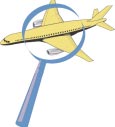 |
||||||
|
|
Number
284
|
May 2003
|
||||
|
P.O. Box 189, Moffett Field, CA 94035-0189 |
||||||
|
|
||||||
 |
||||||
|
|
Number
284
|
May 2003
|
||||
|
P.O. Box 189, Moffett Field, CA 94035-0189 |
||||||
|
|
||||||
The
Case of the Unstable Approach
FAA Order 8400.10
defines a stabilized approach as "maintaining a  stablespeed,
descent rate, vertical flight path, and configuration during the final
stages of an approach." Significant speed and configuration changes
during an approach can complicate tasks associated with aircraft control
and increase the difficulty of evaluating an approach as it progresses.
The evidence presented in these recent ASRS reports demonstrates that
instability is no defense when an approach goes bad.
stablespeed,
descent rate, vertical flight path, and configuration during the final
stages of an approach." Significant speed and configuration changes
during an approach can complicate tasks associated with aircraft control
and increase the difficulty of evaluating an approach as it progresses.
The evidence presented in these recent ASRS reports demonstrates that
instability is no defense when an approach goes bad.
The
Hold Up
Air Traffic Controllers play an important role in the stabilized approach
concept. Appropriate vectors and traffic sequencing help ensure that
approach parameters can be met. But, as this B757 crew pointed out,
Controllers also need to be aware of the unique flight characteristics
of some aircraft.
Lessons learned: 1) We should have gone around and not accepted the set-up. 2) Approach facilities need to be educated about the capabilities of [various aircraft]. Some can't get down and slow up as quickly as others.... You have to plan ahead. 3) Recognize the importance of a stabilized approach. [Final approach] is not the time to be changing runways, working the FMC, configuring the aircraft, etc.
[We] called Approach Control after landing, voiced [our] concerns about how we were handled...and re-emphasized the importance of a stabilized approach.
The
Chase 
Although this Captain did manage to catch up to the aircraft and land
without incident, a clean getaway and fresh start might have been a
wiser course of action.
The
Capture
Without anticipating adjustments required for adverse conditions, a
flight crew has little chance of establishing a stabilized approach.
This CL-65 crew wisely departed the scene when the alarm went off and
managed a more successful glideslope capture the second time around.
The
Lockup
A good approach usually leads to a good landing. The student pilot who submitted this report learned that the opposite is also true.
From the instructor's report:
The
Escape
This MD80 crew started out
with a good approach but had to change their plans when they got hit
with a low blow.
From The Maintenance Desk
ASRS receives
a number of reports related to aircraft that are damaged during ground
maintenance procedures. Many of these incidents involve a failure to
activate or deactivate systems in accordance with the sequence prescribed
in the appropriate maintenance manual. The maintenance technician who
submitted this report did what he was told to do, but someone should
have checked that all related systems were set up in accordance the
maintenance manual.
When I pushed the Standby Hydraulic circuit breaker in, the pump came on and the leading edge devices came down on the open outboard "C" Ducts (engine cowlings). There was nobody in the cockpit at the time. When someone went up to turn the pump off, they found the Standby Hydraulic switch in the "Armed" position, apparently from the B/C Check the night before. The leading edge lockout pin had already been removed from the valve in the main wheel well.
The engine cowlings and leading edge devices on both sides of a B737-700 were damaged in this incident.
 Tail
End Tales
Tail
End Tales
Although it might seem unlikely that anyone would confuse the MD80/90
tail cone jettison with the aft passenger door/stair operation, two
incidents reported to ASRS confirm what Mr. Murphy said, "If it
can be done wrong, it will be done wrong."
|
ASRS
Recently Issued Alerts On...
|
|---|
| ERJ135 weight and balance incident |
| Unlit taxiway at a major Western airport |
| B737-800 loss of F/O flight instuments |
| MD88 abnormal elevator control response |
| Questionable baggage weight computations |
|
April
2003 Report Intake
|
|
|---|---|
| Air Carrier/Air Taxi Pilots |
1,606
|
| General Aviation Pilots |
832
|
| Controllers |
29
|
| Cabin/Mechanics/Military/Other |
154
|
| TOTAL |
2,621
|